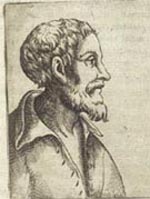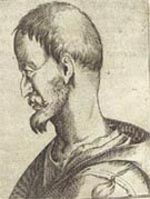
The History of Physiognomy
A Leverhulme Trust International Network
Queen Mary University of London (London), Ecole Normale Supérieure (Paris), and Scuola Normale Superiore (Pisa)

 |
The History of PhysiognomyA Leverhulme Trust International NetworkQueen Mary University of London (London), Ecole Normale Supérieure (Paris), and Scuola Normale Superiore (Pisa) |
 |
|
HomeAbout the NetworkAbout PhysiognomyContactMembersParticipantsEventsBibliographyResources/Links |
Participants
Malcolm Baker,University of California, Riverside
Eniko Békés, Hungarian Academy of Sciences, Institute for Literary Studies Research: Humanism, Neo-Latin literature in Hungary and its connections with Italy; Publications: Current research project: The De doctrina promiscua of Galeotto Marzio and the self-representation of the Medici family.
David Bindman, UCL
Lina Bolzoni, Scuola Superiore Normale, Pisa
Tommaso Casini, Università del Salento
Jean-Jacques Courtine, Professor of Anthropology, Université de la Sorbonne Nouvelle (Paris III) Publications on physiognomy (or related): a. (2007 [1988]): Histoire du visage (Exprimer et taire ses émotions, du XVIème au début du XIXème siècles), with Cl. Haroche, Paris, Rivages/Histoire, 287 p. [1988 Psyche Prize for the History of Medecine & Psychiatry]. forthcoming b. (2005-2006): Histoire du corps (XVI-XXème siècle), 3 vol., [generalco-editor; editor, vol. III: XXth c.], in collaboration with A. Corbin (Institut Universitaire de France) & G. Vigarello (Institut Universitaire deFrance & EHESS), Paris, Le Seuil (« L?Univers historique »), 1650 p.- - Portuguese translation (Portugal), Lisbon, Afrontamento, forthcoming. Current research project: (scheduled for Fall 2010) : Histoire de la virilité (de l?Antiquité au XXIème siècle) / History of Manliness (From Antiquity to the XXIth Century, [general co- editor ; editor : volume III, XXth Century], in collab. with Alain Corbin (Institut Universitaire deFrance) & Georges Vigarello (EHESS), 3 vol., Paris, Le Seuil (« L?univers historique »), c. 1800 p.
Jean Dagen
Dr Thomas Dixon, Centre for the History of the Emotions, Queen Mary, University of London. Personal website: http://www.history.qmul.ac.uk/staff/dixont.html Research and Publications: I have previously published on the history of theories of 'passions' and 'emotions' in theological, philosophical, scientific and medical contexts, especially in the nineteenth century. My new research project looks at Stoicism, public weeping, and Victorian regimes of emotional expression and control. Details of publications are available on my staff webpage.
Mark Greengrass, Sheffield University
Pascal Griener, Université de Neuchâtel
Martial Guédron, Professor of History of art, UFR Sciences Historiques/Université Marc Bloch, Strasbourg Cedex
Yves Hersant, Ecole des Hautes Etudes en Sciences Sociales, Paris
Colin Jones, Department of History, Queen Mary, University of London
Dr. Anu Korhonen, Academy of Finland Research Fellow Renvall Institute, University of Helsinki
Nadeije Laneyrie-Dagen (Ecole Normale Supérieure, Paris)
Frédéric Le Blay, Maître de Conférences en littérature et civilisation latines, Université de Nantes, Chemin de la Censive-du-Tertre, BP 81227, 44312 Nantes Cedex 03
Benoîte Legeais, Université de Montréal & Université de Paris III-Sorbonne Nouvelle
Anne-Sophie Molinié, Université Paris Sorbonne (Paris IV)
Dr. Jennifer Montagu, The Warburg Institute (University of London) Contact details: The Warburg Institute, Woburn Square, London WC1A 0AB
Colette Nativel, Paris 1-Panthéon-Sorbonne (CHAR)
Vivian Nutton, Wellcome Centre for the History of Medicine, UCL
Nicole Pellegrin, IHMC/CNRS-ENS, Paris
Melissa Percival, Exeter University
Martin Porter, Lyon
Christina Posselt M A. Research: "The portrait in Giorgio Vasari's Vite" (dissertation project):
Eugenio Refini, PhD Candidate, Scuola Normale Superiore in Pisa, Department of Literature and Arts), Piazza dei Cavalieri, 7, 56100 Pisa – IT Personal website: http://eugeniorefini.blogspot.com/ Publications on Physiognomy (or related): Current research: Allegorical Personifications in Renaissance Drama.
Dr Natasha Ruiz-Gómez, RCUK Fellow and Graduate Director, Department of Art History and Theory, University of Essex, Wivenhoe Park, Colchester, CO4 3SQ Publications on physiognomy (or related): Natasha Ruiz-Gómez, ‘Essence and Evanescence in the Hands of Rodin’, Thresholds, 31 (May 2006): 102–109. Description of research and current projects: My research examines the intersections of science and art in late-nineteenth- and early-twentieth-century France. My current book manuscript proposes a new reading of Auguste Rodin’s sculpture based on an examination of the science of the time, including the persistent role of physiognomy and the related study of regional types in reading individuals’ physical features for morality and intellect. This study shows that Rodin’s oeuvre is clearly bound up with and indebted to the science of his day, revealing a heretofore unrecognized source of the sculptor’s inspiration and contributing a fresh interpretation of many of his most important works. My publications include essays on Rodin’s sculpture, on his collection of photographs and on contemporary architecture. In addition to my book on Rodin, my current research projects include a book-length study of the intersections of photography and science in late-nineteenth-century France. Professor George Rousseau, Oxford University Personal website: http://www.history.ox.ac.uk/research/clusters/history_childhood/ Research: Professor Rousseau is an American cultural historian. He was educated at Amherst College and Princeton University where he obtained his doctorate. From 1966 to 1968 he was part of the English Faculty at Harvard University, before moving to a professorship at UCLA, and later to the Regius Chair of English at Aberdeen University in Aberdeen, Scotland. He is also a Fellow of the Royal Historical Society. Since then he has been attached to the History Faculty at Oxford University in Oxford, England where he is a Co-Director of the Centre for the History of Childhood. Rousseau is a cultural historian who works in the interface of literature and medicine, and emphasizes the relevance of imaginative materials - literature, especially diaries and biography, art and architecture, music - for the public understanding of medicine, past and present. In 2007 he was awarded an honorary doctorate honoris causa by the University of Bucharest, Romania. Publications: See http://en.wikipedia.org/wiki/George_Rousseau
Sebastien Schutze, Queen’s University, Kingston
Jon Snyder, University of California, Santa Barbara
Luke Syson, National Gallery
Dr. Sabine Vogt (Berlin), Editor for Classical and Ancient Near Eastern Studies, Walter de Gruyter Publishers, Berlin & New York. Academically affiliated to Ludwig-Maximilians-Universität München, Germany.
Caroline Warman, Jesus College, Oxford Shearer West, University of Birmingham and Arts and Humanities Research Council
Professor Joseph Ziegler, Department of General History, University of Haifa Research: I am preparing a monograph on the rise of learned physiognomy 1200-1500. My research is based on the study of the main physiognomic manuals and the commentaries on Ps.-Aristotle's physiognomy. It targets the topic of physiognomy from the perspective of the History of Science. I am currently preparing a paper on biological explanations of virtuous behaviour and virtues in physiognomic texts. Select publications:1. ‘Skin and Character in Medieval and Early Renaissance Physiognomy’, Micrologus, 13 (2005), 511-535.2. ‘Sexuality and the Sexual Organs in Latin Physiognomy 1200–1500’, Studies in Medieval and Renaissance History, Third Series, 2 (2005), 83-108.3. 'Philosophers and Physicians on the Scientific Validity of Latin Physiognomy, 1200-1500', Early Science and Medicine 12 (2007), 285-312.4 ‘The Beginning of Medieval Physiognomy: The Case of Michael Scotus‘, in Kulturtransfer und Hofgesellschaft im Mittelalter: Wissenskultur am sizilianischen und kastilianischen Hof im 13. Jahrhundert, ed. Gundula Grebner and Johannes Fried (=Wissenskultur und gesellschaftlicher Wandel, vol. 15) (Berlin: Akademie Verlag, 2008), pp. 299-319.5. 'Hérédité et physiognomonie', in L’ hérédité entre Moyen Âge et Époque moderne: Perspectives historiques, ed. Maaike van der Lugt and Charles de Miramon (Florence: Sismel, 2008), pp. 245-272. 6. 'Physiognomy, Science, and Proto-Racist Thought 1200-1500', in The Origins of Racism in the West, ed. M. Eliav-Feldon, B. Isaac, J. Ziegler (Cambridge: CUP, 2009), pp. 181-199.7. 'Measuring the Human Body in Medieval and Renaissance Physiognomy' Micrologus [La mesure] (forthcoming) |
|||||